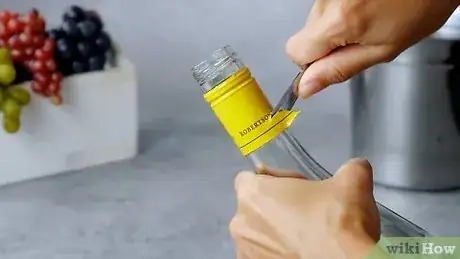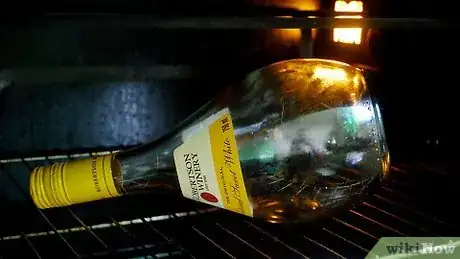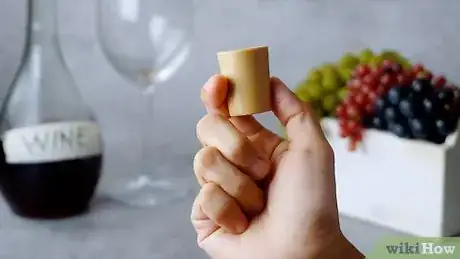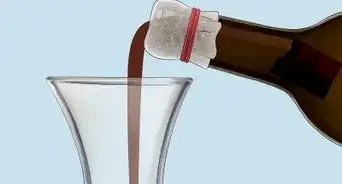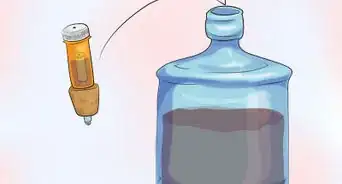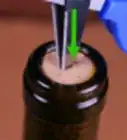This article was co-authored by wikiHow Staff. Our trained team of editors and researchers validate articles for accuracy and comprehensiveness. wikiHow's Content Management Team carefully monitors the work from our editorial staff to ensure that each article is backed by trusted research and meets our high quality standards.
There are 7 references cited in this article, which can be found at the bottom of the page.
The wikiHow Culinary Team also followed the article's instructions and verified that they work.
This article has been viewed 97,889 times.
Learn more...
Crafting your own wine is a gratifying and delicious endeavor, but can be expensive for those who are first starting out. Once you’ve made a batch, you will need proper containers in which to store the wine. Though stores will sell you new bottles for this purpose, you can save some money by reusing any old screw-top wine bottles you already own, with just a little preparation.
Steps
Stripping the Bottle of Labels and Skirt
-
1Remove the skirt from the bottle. Many screw-top wine bottles come with a collar or skirt attached to the neck of the bottle. These skirts help regulate the amount of oxygen that can reach the wine, and are meant to emulate the foil wrap found on traditional corked bottles. These skirts are often made of a lightweight metal such as tin or aluminum. To remove the skirt:
- Twist off the foil along with the cap. Thinner skirts can often be removed with the cap by gripping the skirt along the base and giving a quick twist, opening the cap and loosening the skirt all at once. Remove in one piece.
- Pry the skirt away with a screwdriver or other flat tool. Should the skirt remain on the bottle after opening, you may need to pry it away. Use a wedged tool such a screwdriver to create a flap on the skirt. Continue to pry with the screwdriver, or use pliers to pull away the skirt.
- Cut the skirt away with a sharp knife. Depending on the thickness of the skirt, a sharp knife can create an incisive flap, which can be used to peel the skirt away. Be careful when using knives or screwdrivers to avoid a slip of the hand and injury.
-
2Remove the labels from the bottle by soaking. For keeping track of your wine and storing them properly, you’ll want to make sure you don’t get confused by incorrect labeling. Soaking the bottles in a few homemade solutions is a simple way of removing labels from bottles and requires just a few household items.
- Fill a bucket with water.
- Add 1 tablespoon of baking soda for every 2 cups of water; alternatively, add 1/4 cup of ammonia.
- Soak the bottles in the bucket for 30 minutes.
- Labels will detach while soaking.
- Manually peel off any labels that do not fully detach. Gloves recommended if soaking in ammonia.
Advertisement -
3Remove the labels from the bottle through heat. If you want to save the labels from your bottles for later use, you can remove them safely by using heat.
- Bring a pot of water to a boil.
- Hold the wine bottle over the boiling water for 10 to 15 minutes.
- The glue will soften. Carefully remove label from the bottle with your hands (may be hot).
- Can be steamed for an additional 10 to 15 minutes if the label will not remove.
- Bottles may also be baked in the oven for 10 minutes at 375 degrees Fahrenheit to loosen the glue holding the labels.[1]
Cleaning and disinfecting the bottle
-
1Remove remaining residue. Some labels will leave a film of residue on the bottle after they have been removed. This residue can often be removed with soap and warm water, and gentle scrubbing with a dish-safe abrasive such as a scrubbing pad. Steel wool may also work, but can run the risk of scratching the bottle.
-
2Sterilize the bottle. Regular cleaning methods of soap and water will not always destroy the bacteria and other germs that can remain in the bottle. Since you are storing wine in these bottles for a period of time, it is essential to ensure the bottle is as sterile as possible.
- Purchase a water-mixable oxygenating cleaner.
- Mix the solution as per the instructions provided on the cleaner.
- Submerge the bottles in the solution according to instructions.
- Once finished soaking, allow to dry. Sanitation occurs while the bottle is drying.[2]
-
3Remove spots and stains on inside of the bottle. Cleaning the inside of a bottle so that it is spot-free can be difficult. Two solutions can help remove those stains:
- Fill the wine bottle one-quarter full with uncooked rice.
- Add enough liquid soap to fill the bottle half way.
- Fill the remainder of the bottle with hot water.
- Replace screw-top or stop the opening of the bottle and shake vigorously for several minutes.
- Allow the water to cool.
- Pour out the contents of the bottle. [3]
- Alternatively, you can use a bottle brush along with soap and water to scrub the inside of the bottle.[4]
Bottling your wine
-
1Create a label for your wine. How you label your wine is entirely up to you. There are many resources for purchasing wine label templates or even customizing a wine label, for a price. However, nothing is stopping you from using masking tape and a marker in order to label your wine. Note that the Alcohol and Tobacco Tax and Trade Bureau has several requirements for wine labeling in the United States (such as vintage date, alcohol content and declaration of sulfites), so keep this in mind if you plan on selling your wine.[5]
-
2Fill the bottle with wine. Insert your home-grown wine into the bottles in accordance with how the wine was prepared. You may also fill the bottles at your local vintner, for a price.
-
3Close the bottle with a screw-top. As you are reusing a screw-top bottle, you may still have the original top for the bottle. This screw cap can be reused for sealing your wine. However, note that since the original seal was broken, recreating the same air tight conditions will be difficult, if not impossible, and thus it cannot be guaranteed that air and bacteria will not be able to enter the bottle.[6] As such, reusing screw-top bottles best lends itself to short-term storage.
-
4Close the bottle by corking (not recommended). Reused screw-top bottles can be corked for longer term storage, but this is generally not advised, as screw-top bottles are not made to support corks, and are much more prone to breaking during the process. If you would like to cork your bottle, do the following:
- Purchase a corker. Corkers are divided into smaller hand models, and larger bench or floor models. Bench and floor models allow for quicker corking and are ideal for corking a large quantity of bottles. Hand models are more suited for smaller batches of bottles.
- Prepare your cork. Corks are hard and rigid upon purchase and need to be softened before being inserted into the bottle. Soak the corks in water for several minutes before corking in order to provide pliability to the corks. They may also be steamed in a pan of water for 1 to 3 minutes until pliable to the touch.
- Once pliable, use the corker to insert the cork into the bottle.
- Leave bottles standing up-right between 1 and 2 days to give the corks time to re-expand and create a seal in the neck of the bottle.[7]
Community Q&A
-
QuestionWhen re-using screw-top bottles to store homemade red wine, should the bottles be stored upright, or can they be laid flat or stored in a rack?
 Community AnswerLay on the side to see if caps are leaking. Leave for at least three days and replace any cap that you notice leaking.
Community AnswerLay on the side to see if caps are leaking. Leave for at least three days and replace any cap that you notice leaking. -
QuestionOnce a cork is soaked in water, will it fit into a reused screw top bottle?
 Community AnswerIt should, but don't force it, or you could damage the bottle's neck. You can always taper a cork to get a better fit by sanding down one end of a dry cork before soaking.
Community AnswerIt should, but don't force it, or you could damage the bottle's neck. You can always taper a cork to get a better fit by sanding down one end of a dry cork before soaking. -
QuestionHow do I stop leaks on my reusable wine screw top?
 Community AnswerGet a new cap or invest in some bottles designed for corks. The bottles are relatively cheap. Do not reuse the corks after you finish that bottle; there is no need, as for you can get them in bulk cheaply. Just try not to get corks with ink designs as for when you rack they may seep into your drink and spoil the flavours.
Community AnswerGet a new cap or invest in some bottles designed for corks. The bottles are relatively cheap. Do not reuse the corks after you finish that bottle; there is no need, as for you can get them in bulk cheaply. Just try not to get corks with ink designs as for when you rack they may seep into your drink and spoil the flavours.
Warnings
- Wear oven mitts while baking the wine bottles.⧼thumbs_response⧽
- Take proper precautions when dealing with high heat, chemicals or sharp blades.⧼thumbs_response⧽
References
- ↑ http://www.popularmechanics.com/home/how-to/a3085/how-to-remove-a-bottle-label/
- ↑ http://www.eckraus.com/blog/sanitizing-cleaning-wine-bottles
- ↑ http://www.howtocleanstuff.net/how-to-clean-stains-and-oil-from-glass-bottles/
- ↑ https://winemakermag.com/blogs/cleaning-a-re-using-bottles
- ↑ http://www.ttb.gov/pdf/brochures/p51901.pdf
- ↑ http://winemakermag.com/969-can-i-reuse-bottles-with-screw-on-caps-for-bottling-wine
- ↑ http://www.eckraus.com/wine-making-corking
